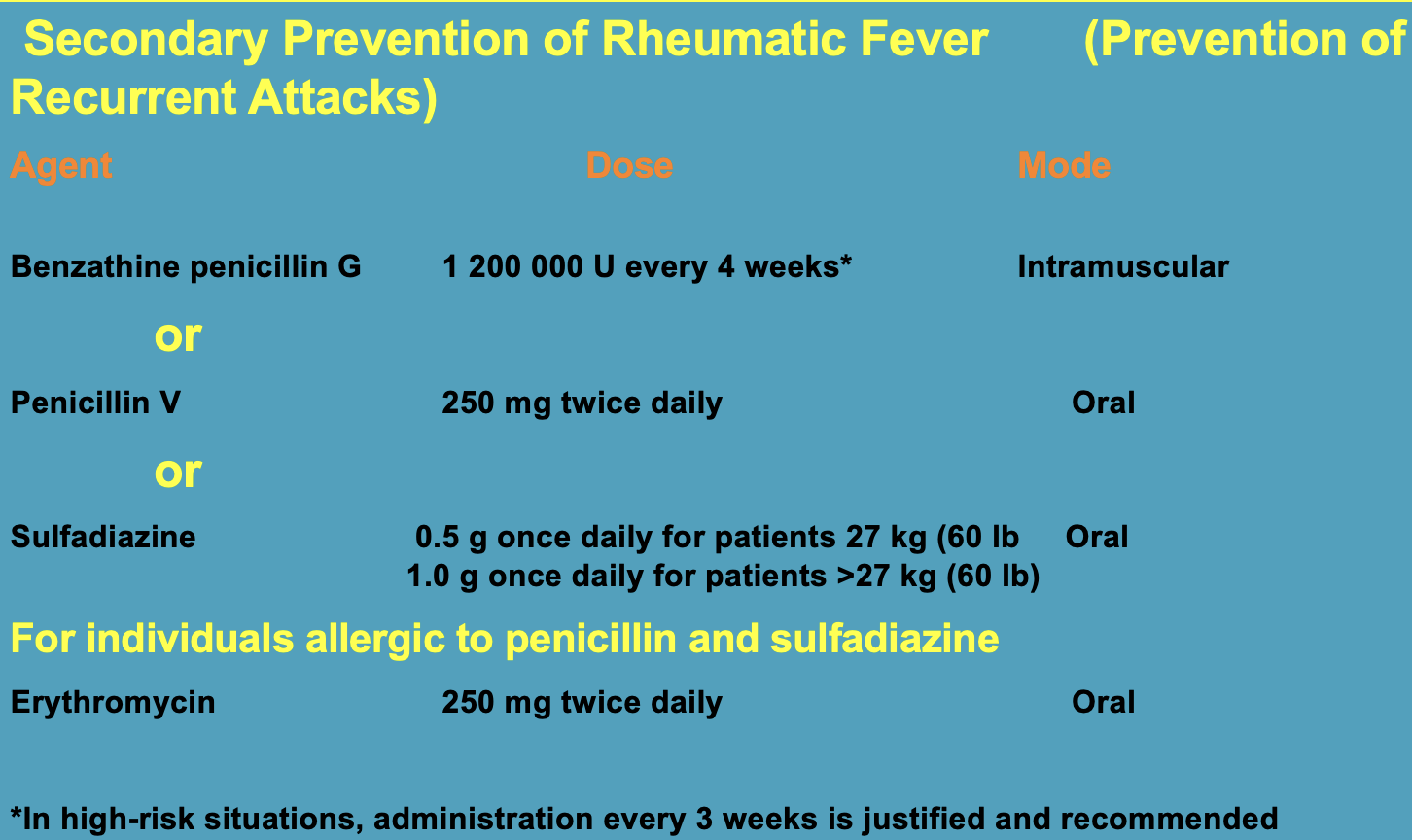Step I - primary prevention (eradication of streptococci) by suitable antibiotics
Step II - Suppression of the acute inflammatory response by anti-inflammatory drugs. (aspirin, steroids)
Step III- supportive management & management of complications
Step IV- secondary prevention (prevention of recurrent attacks)
Ensuring that patients understand their disease, are informed regarding their future and receive secondary prophylaxis - EDUCATION/Health education is critical at all levels - Lack of parental awareness of the causes and consequences of ARF/RHD is a key contributor to poor adherence amongst children on long-term prophylaxis.
- Carditis -corticosteroids
- Arthritis - Large aspirin doses
Drug therapy:
1-Eradication of streptococcal infection:
A) Non pharmacological:
- Absolute bed rest in acute stage (to avoid or prevent further complications especially the heart);
- 2-3 weeks in absence of carditis with gradual resumption to normal activities.
- In presence of carditis 4 weeks.
- In presence of heart failure or cardiomegaly 8 weeks
- or until complications subsides.
- Salt and fluid restriction, Bed rest
B) Treatment of congestive cardiac failure: -digitalis, diuretics C) Treatment of chorea: -diazepam or haloperidol D) Rest to joints & supportive splinting
2-Suppression of acute inflammation:
A) Salicylates: aspirin
Indications: acute rheumatic fever without carditis. Dose: 100 mg/kg/day till clinical manifestations disappear, then 50 mg/kg/day for about one month. If patient allergic to penicillin (piroxicam or celecoxib).
B)Corticosteroids: prednisolone or dexamethazone.
Indications:
- acute rheumatic fever with carditis or CHF
- patients without carditis who respond inadequately to aspirin.
Dose: prednisolone: 2mg/kg/day /6hours orally doses until clinical and laboratory manifestations of rheumatic fever disappear. Then the dose is reduced gradually over 2-3 weeks to avoid?
Prevention of recurrence: Benzathine penicillin: Dose: 1,200,000 IU / 3-4 weeks by deep IM injection When to stop prophylaxis?

Secondary prevention: Duration
| CATEGORY | DURATION OF PROPHYLAXIS |
|---|---|
| All persons with ARF with no or mild carditis | MINIMUM 10 years after most recent episode or age 21 |
| All persons with ARF and moderate carditis | MINIMUM 10 years after most recent episode or age 35 |
| All persons with ARF and severe carditis | MINIMUM 10 years after most recent episode or age 35 and then specialist review for need to continue. Post surgical cases definitely lifelong. |
| PENCILLIN | |
| Secondary prophylaxis also reduces the severity of RHD. | |
| It is associated with regression of heart disease in approximately 50-70% of those with good adherence over a decade and reduces mortality. | |
| Route: BPG is most effective when given as a deep intramuscular injection. |
How can we reduce the pain associated with IM Penicillin?
-
Use a 23-gauge needle- deeper is better
-
Local pressure to area for 10 secs
-
Warm syringe to room temperature
-
First allow alcohol to dry or use ethylchloride spray
-
Deliver injection very slowly(over 2-3mins)
-
Distraction techniques
-
Use 0.5-1ml of 1% lignocaine. Reduces pain significantly and excellent for younger patients.
Aspirin Aspirin in anti-inflammatory doses effectively reduces all manifestations of the disease except chorea, and the response is typically dramatic.
If rapid improvement is not observed after 24-36 hours of therapy, question the diagnosis of rheumatic fever.
Maintain aspirin at anti-inflammatory doses until the signs and symptoms of acute rheumatic fever are resolved or residing (6-8 wk) and the acute phase reactants (APRs) have returned to normal.